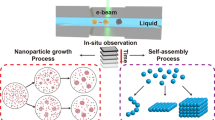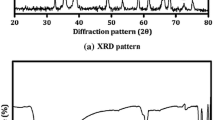Abstract
Iron carbide nanoparticles were synthesized by laser ablation of iron in alcohols (methanol and ethanol). A new cell, designed to allow the ablation to be conducted in a flowing solvent, enabled separation and collection of the nanoparticles immediately after production, thus preventing further photochemical reactions of the colloids. The nanoparticles were investigated using Mössbauer spectroscopy, X-ray diffraction, and transmission electron microscopy. In methanol, they consisted of α-iron, γ-iron, iron carbide, and amorphous paramagnetic iron carbides, whereas in ethanol they consisted of iron carbides and amorphous paramagnetic iron carbides. The difference in products depending on the alcohol was attributed to the different carbon supplies for methanol and ethanol. For both solvents, the average particle size was found to be 16 nm, and the nanoparticles were dispersed in amorphous carbon. We also examined the effect of further laser irradiation of the colloids using stagnant solvent, and the particle size was found to increase and a very small amount of carbonization was observed.
Similar content being viewed by others
References
Yang, C., Zhao, H., Hou, Y., Ma, D.: Fe 5 C 2 Nanoparticles: A Facile Bromide-Induced Synthesis and as an Active Phase for Fischer −Tropsch Synthesis. J. Am. Chem. Soc. 134, 15814–15821 (2012)
Hu, Y., Jens, O.J., Zhang, W., Cleemann, L.N., Xing, W., Bjerrum, N.J., Li, Q.: Hollow spheres of iron carbide nanoparticles encased in graphitic layers as oxygen reduction catalysts. Angew. Chem. Int. Ed. 53, 3675–3679 (2014)
Meffre, A., Mehdaoui, B., Kelsen, V., Fazzini, P. F., Carrey, J., Lachaize, S., Respaud, M., Chaudret, B.: A Simple Chemical Route toward Monodisperse Iron Carbide Nanoparticles Displaying Tunable Magnetic and Unprecedented Hyperthermia Properties. Nano. Lett. 12, 4722–4728 (2012)
Pérez-Cabero, M., Taboada, J.B., Guerrero-Ruiz, A., Overweg, A.R., Rodríguez-ramos, I.: The role of alpha-iron and cementite phases in the growing mechanism of carbon nanotubes: a 57fe mössbauer spectroscopy study. Phys. Chem. Chem. Phys. 8, 1230–1235 (2006)
Yoshida, H., Takeda, S., Uchiyama, T., Kohno, H., Homma, Y.: Atomic-scale In-situ Observation of Carbon Nanotube Growth from Solid State Iron Carbide Nanoparticles. Nano. Lett. 8(7), 2082–2086 (2008)
Bi, X., Ganguly, B., Huffman, G., Huggins, F., Endo, M.: Nanocrystalline α−Fe, Fe 3C, and Fe 7 C 3 produced by CO 2 laser pyrolysis. J. Mater. Res. 8(7), 1666–1674 (1993)
Tanaka, T., Nasu, S., Ishihara, K.N., Shingu, P.H.: Mechanical alloying of the high carbon Fe-C system. J. Less-Common Metals 171, 237–247 (1991)
Miani, F., Matteazzi, P., Basset, D.: Mechanosynthesis of iron carbides at composition Fe 75 C 25: modeling of the process kinetics. J. Alloys and Compounds 204, 151–156 (1994)
Miyatani, R., Yamada, Y., Kobayashi, Y.: Mössbauer study of iron carbide nanoparticles produced by synthesis. J. Radioanal. Nucl. Chem. 330(2), 1503–1506 (2015)
Yamada, Y., Shimizu, R., Kobayashi, Y.: Iron oxide and iron carbide particles produced by the polyol method. Hyperfine Interact. 237, 6 (2016)
Mafuné, F., Kohno, J., Takeda, Y., Kondow, T.: Formation and size control of silver nanoparticles by laser ablation in aqueous solution. J. Phys. Chem. B 104, 9111–9117 (2000)
Amendola, V., Riello, P., Meneghetti, M.: Magnetic nanoparticles of iron carbide, iron oxide, Iron@Iron oxide, and metal iron synthesized by laser ablation in organic solvents. J. Phys. Chem. C 115, 5140–5146 (2011)
Franzel, L., Bertino, M.F., Huda, Z.J., Carpenter, E.E.: Synthesis of magnetic nanoparticles by pulsed laser ablation. Appl. Surf. Sci. 261, 332–336 (2012)
Matsue, T., Yamada, Y., Kobayashi, Y.: Iron carbide nanoparticles produced by laser ablation in organic solvent. Hyperfine Interact. 205, 31–35 (2012)
Niidome, Y., Hori, A., Sato, T., Yamada, S.: Enormous size growth of Thiol-passivated gold nanoparticles induced by near-IR laser light. Chem. Lett. 29(4), 310–311 (2000)
Tsuji, T., Yahata, T., Yasutomo, M., Tsuji, M., Igawa, K., Ishikawa, Y., Koshizaki, N.: Preparation and investigation of the formation mechanism of submicron-sized spherical particles of gold using laser ablation and laser irradiation in liquids. Phys. Chem. Chem. Phys. 15, 3099–3107 (2013)
Author information
Authors and Affiliations
Corresponding author
Additional information
This article is part of the Topical Collection on Proceedings of the 2nd Mediterranean Conference on the Applications of the Mössbauer Effect (MECAME 2016), Cavtat, Croatia, 31 May-3 June 2016
Rights and permissions
About this article
Cite this article
Amagasa, S., Nishida, N., Kobayashi, Y. et al. Mössbauer study of iron carbide nanoparticles produced by laser ablation in alcohols. Hyperfine Interact 237, 110 (2016). https://doi.org/10.1007/s10751-016-1322-5
Published:
DOI: https://doi.org/10.1007/s10751-016-1322-5




